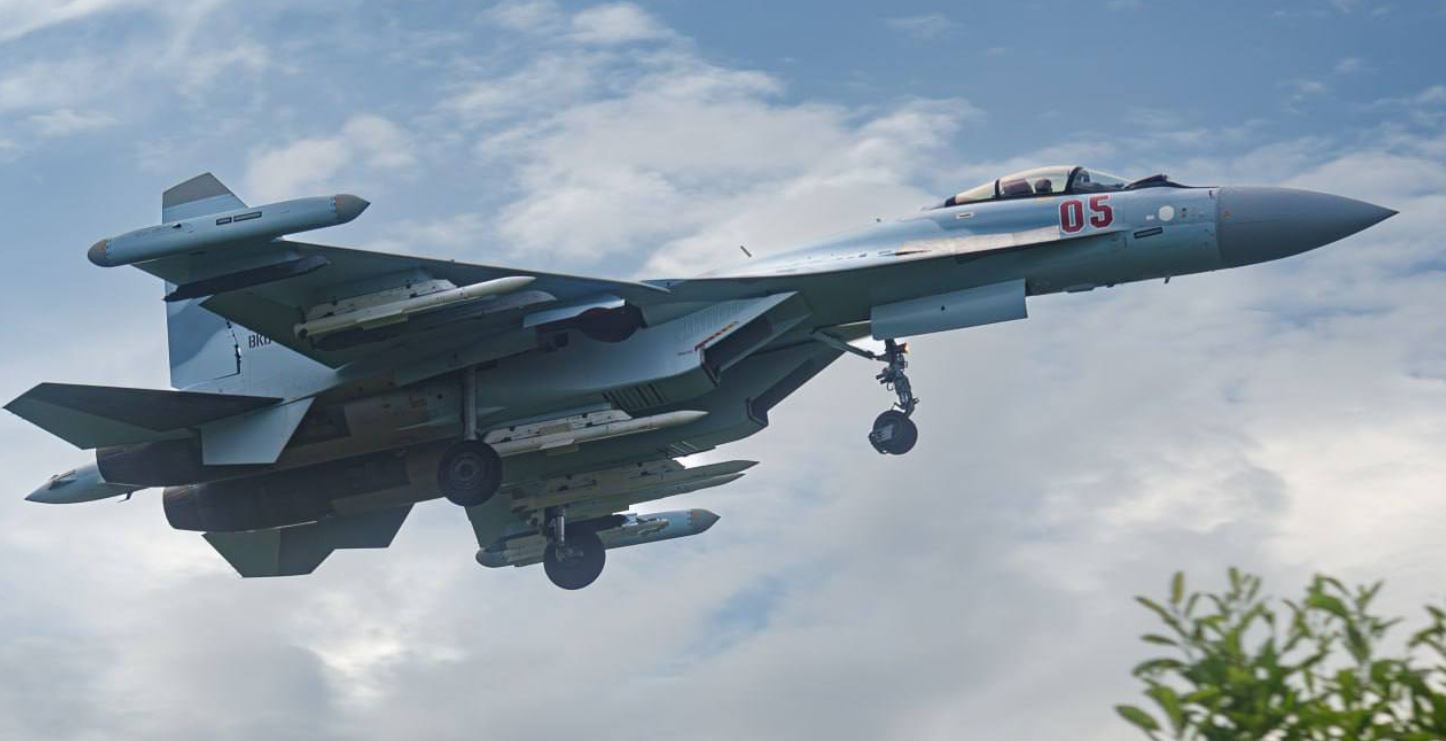After the 250-mile range air-to-air (AAM) missile R-37M, the Ukrainian Air Force has a new threat to deal with. The latest images on social media seem to show a Russian Su-35 fighter jet carrying a modified R-77M beyond-visual-range AAM.
The images suggest that an updated version of the R-77, known to NATO as the AA-12 Adder, is not only operational but also in active use by the Russian Air Force (RuAF) in the Ukraine War.
Notably, the missile, initially developed to be carried internally by the Russian fifth-generation aircraft Su-57, utilizes an active phased array antenna (APAA) seeker, which makes it extremely difficult for a targeted aircraft to break the missile’s lock.
This makes the R-77M a “fire and forget” weapon, giving it a large ‘no escape zone.’
Russian AAM To Counter Chinese PL-15, US Missiles?
The Chinese PL-15, a medium- to long-range missile, also utilizes an Active Electronically Scanned Array (AESA) radar. The PL-15 shot to prominence in the recent four-day war between Indian and Pakistan in May, which also involved an intense aerial battle.
Pakistan claimed to have shot down as many as five Indian fighter jets, including Rafales, by using the export variant of the Chinese PL-15 BVR AAM. While India acknowledged combat losses, it denied having lost five jets to enemy fire.

Russian Su-35 carrying upgraded R-77M AAM. Credits platform X.
In fact, the latest versions of the Patriot surface-to-air missile (SAM) system, manufactured by Raytheon in the United States, reportedly also use a similar seeker.
Earlier versions of the Patriot system, such as those equipped with the AN/MPQ-53 and AN/MPQ-65 radar sets, used passive electronically scanned array (PESA) radars.
However, in 2017, the Patriot system was upgraded with the AN/MPQ-65A radar, which incorporates a gallium nitride (GaN)-based AESA radar. This upgrade replaced the older passive array with a solid-state AESA system featuring multiple transmit/receive modules.
However, what sets the Russian R-77M apart is that it is small enough to be carried by Su-35 on its external pylons and even by the Su-57 in its internal weapons bay.
The Evolution Of The R-77 Family
The R-77M’s APAA seeker radar represents a significant improvement over the R-77’s conventional active radar seeker, typically a monopulse Doppler radar developed by OAO Agat.
Russia (formerly the Soviet Union) began developing the active-radar-guided R-77, also known as the Izdeliye 170, back in the early 1980s. However, soon the Soviet Union became history, and the economic turmoil that followed meant that R-77s never entered operational service with the RuAF.
According to the Institute for Strategic Studies (IISS), “The R-77 (Izd. 170) never entered service with the Russian Air Force, as the service did not have the funding to acquire it during the latter part of the 1990s and early 2000s. By the time this situation had been redressed, a first-stage upgrade of the design was in the pipeline.”
Later, Russia introduced the upgraded R-77-I, also known as izdeliye 170-1, which was used in Syria in 2015. Notably, the R-77-I was the first active radar-guided medium-range missile in Russia’s inventory.
On the other hand, the United States’ AIM-120 AMRAAM, the missile that the R-77 was designed to counter, entered service in 1991, while the Chinese equivalent, the PL-12, entered service around 2005.
In June 2019, the Russian Ministry of Defense and missile designer Vympel signed the order for Item (Izdeliye or Izd.) 180 (R-77M) during the Armiya 2019 defense exhibition, held near Moscow.
Initially, the order was placed for the Su-57. However, now the upgraded missile has also been integrated with the Su-35 fighter jet.
The R-77M represents further improvements over the R-77-I. Specifically, it features an APAA seeker radar, very similar to AESA radar, integrating many small transmit/receive modules (TRMs), often 64 or more, with each module acting like a mini-radar, independently sending and receiving signals.
This reportedly gives the R-77M a 360-degree coverage, eliminating the “blind spots.”
This also makes the missile more resistant to electronic countermeasures.
Furthermore, the R-77M features a dual-pulse motor, ensuring that thrust output is maintained throughout the missile’s flight path, resulting in better maneuverability, an extended range, and enhanced performance during the last phase of the missile’s flight.
This provides the missile with a larger ‘no escape zone’ than its predecessor.
The R-77M is speculated to have a range exceeding 190 km. For comparison, China’s PL-15 is estimated to have a range of 200–300 km. However, the export variant of the PL-15, the PL-15E, is estimated to have a range of nearly 150 km.
The official performance data for the American AIM-120D is classified. However, it is believed to have a range of between 160 and 180 km.
Notably, Vympel, the manufacturer of the R-77M missile, has previously claimed that the R-77M is superior to the AIM-120C-7 and comparable to the AIM-120D.
Thus, the R-77M is one of the longest-range AAMs featuring an AESA/APAA radar.
According to former IAF fighter pilot and defense analyst Vijainder K Thakur, “Agile fighters have traditionally been able to evade air-to-air missiles by exploiting the limited field of view of the missile’s radar—maneuvering sharply to slip out of the narrow tracking beam of an adversary fighter in close proximity.”
“The K-77M’s (R-77M) APAA system is designed to counter such escape tactics by instantaneously reorienting its tracking beam, potentially giving it the longest ‘no-escape range’ of any air-to-air missile currently in existence.”
The R-77 appears to be a significant air-to-air missile program for the Russian Air Force. The weapon is expected to provide a significant boost in range, seeker effectiveness, and resistance to countermeasures.
These improvements in the R-77M will undoubtedly create more problems for the Ukrainian Air Force, which is already struggling with the Russian long-range AAMs, such as the R-37M.
Russia Working On MBDA Meteor Challenger?
- Sumit Ahlawat has over a decade of experience in news media. He has worked with Press Trust of India, Times Now, Zee News, Economic Times, and Microsoft News. He holds a Master’s Degree in International Media and Modern History from the University of Sheffield, UK.
- VIEWS PERSONAL OF THE AUTHOR.
- He can be reached at ahlawat.sumit85 (at) gmail.com




